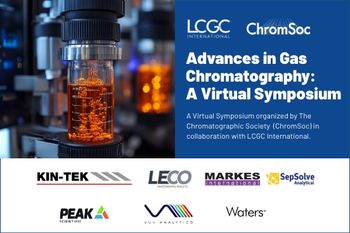
- July 2022
- Volume 40
- Issue 7
- Pages: 321–323
The Crucial Step in Every Analytical Workflow: Sample Preparation—Are We Ready For a Growing Area of Intact Protein Analysis?

New sample preparation workflows for intact proteins in biological matrices are needed. We hope that others will join in this important field of research.
Proteins are biomolecules with a lot of essential functions in a human body. Their varied expression during complex disorders, including cancer, predicts their potential use as biomarkers. Therefore, there is a need for reliable analytical workflows for their analysis in complex biological matrices. Despite the very sensitive and advanced instrumentation we have available for protein analysis today, sample preparation still remains one of the biggest challenges.
Targeted top-down proteomics based on mass spectrometry (MS) platforms connected with liquid chromatography (LC) or capillary electrophoresis (CE) as separation techniques is a fast-growing research area (1–3). Whether it is the pharmaceutical industry moving in the direction of biopharmaceuticals, or clinical researchers looking for novel protein biomarkers, there is immense demand for reliable bioanalytical workflows to target these biomolecules in complex biological matrices (4,5). There have been more than 15,000 different proteins identified in major human body fluids. Those circulating proteins can play an important role as biomarkers and potential drug targets in various disorders, including cancer, neurodegenerative, and inflammatory- mediated diseases (1).
Biological fluids also contain vast amounts of other chemical species including salts, metabolites, and lipids. Therefore, reliable quantitative analysis of intact proteins in complex biological samples using MS still comes with significant challenges. The drawbacks of existing techniques include low overall sensitivity because of the poor ionization and fragmentation efficiencies of intact proteins, the nonspecific binding of proteins to various surfaces of analytical instruments, and the often time-consuming, expensive, and laborious sample preparation steps needed before analysis. All these concerns make the development of a successful analytical workflow for intact proteins even more difficult because an efficient sample preparation protocol is essential before a powerful separation technique with sensitive and selective detection is used. On the other end, current advanced analytical workflows bring several benefits to the proteomics field, including high accuracy, precision, selectivity, and a multiplexing ability that could be beneficial for determining a whole panel of multiple biomarkers in one run (2,6–8).
Sample Preparation for Intact Proteins in Biological Matrices
The go-to sample preparation methods for proteomics analysis are highly selective and quite expensive immunoaffinity-based methods. Other sample pretreatment techniques frequently used for intact protein analysis involve mainly complex and laborious size-exclusion chromatography (SEC), two-dimensional (2D) gel electrophoresis, or their combinations (1,2,9). During our recent work (6) studying the development of an LC–triple quadrupole mass spectrometry (LC–MS/MS) method for direct quantitation of multiple intact growth factors and cytokines in human body fluids, we realized that there was limited commercial availability of simpler, non-immunoaffinity sample preparation options for intact proteins. These could be different extraction techniques or coacervation systems (10–12), but few options could be found. Therefore, a strong emphasis on the development of such new potential sample preparation methods for isolation and enrichment of multiple intact proteins present in complex samples should be of great interest.
Micro-Elution Solid-Phase Extraction (μSPE)
A common and relatively simple solution for removing interferences caused by the presence of cellular and extracellular matrix components in biological samples is protein precipitation (13,14). However, for proteomics analysis, precipitation can often cause deleterious protein loss. Another potential simple non-immunoaffinity sample preparation technique, already frequently used for analysis of small peptides after protein digest, is solid-phase extraction (SPE) (15,16). SPE generally shows limited selectivity, which can be advantageous if one wishes to purify a wider range of proteins from the sample. Developments in the area of new SPE sorbents has started to focus on new materials and formats to target intact proteins as analytes, although commercially available SPE products of this type are still lacking in the market. SPE in a microplate format (μSPE) is designed for effective isolation and preconcentration of various substances. Microplate SPE has multiple advantages, including the use of small sample volumes, elution into volumes as low as 25 μL, and no need for drying or reconstitution steps. The latter is especially important for intact proteins, which can suffer serious recovery losses during such processes.
Even though success in the adoption of commercially available products aimed for small molecules for preparation of intact proteins may be limited, and these methods still suffer from poor recoveries and detrimental matrix effects, in our latest work we explored the practical opportunities and challenges of applying μSPE to the preparation of lower molecular weight intact proteins (<30 kDa). Under optimum conditions, final recoveries of >65% in urine for all targeted proteins and >50% in serum and plasma for most of the proteins were achieved, as shown in Figure 1. Limits of quantitation (LOQ) were at ng/mL concentration levels (corresponding to a range between approximately 0.35 and 97.6 nM). The preliminary results of this work were presented at 69th ASMS Conference on Mass Spectrometry and Allied Topics (17) and are currently being prepared for publication.
Conclusion
Every year, we see the development of cutting-edge analytical instrumentation and the improvement of the performance parameters, particularly sensitivity, of these instruments. However, even with the most sensitive instrumentation, we are not able to reliably analyze multiple intact proteins in complex biological samples without improvements in the frontend to create a highly efficient, robust, and reproducible sample purification and fractionation strategy. There are no simple universal strategies for sample preparation workflows for intact proteins and there is plenty of room to invent. We must continue to develop workflows capable of reaching proteins at very low concentration levels (pg/mL to ng/mL) in complex matrices, providing the appropriate selectivity for proteins of interest and removing potential interferences. The systematic study of the application potential of non-immunoaffinity–based sample preparation methods for intact protein analysis in biological fluids will continue to be a focus of our future work. We hope that others will also see this need and opportunity to contribute to an important field of research.
Acknowledgments
I would like to gratefully acknowledge Professor Kevin A. Schug for his support throughout my research stays in his laboratory, valuable discussions, comments, and suggestions during the experimental work and manuscript writing. Two research stays in Professor Schug’s laboratory at the University of Texas at Arlington were supported by the Fulbright Scholarship Program and the National Scholarship Program of the Slovak Republic. This work was also partially supported by the Scientific Grant Agency of the Ministry of Education, Science, Research and Sport of the Slovak Republic under the project VEGA 1/0483/20, and the article is based upon work from the Sample Preparation Study Group and Network supported by the Division of Analytical Chemistry of the European Chemical Society.
References
(1) S.L. Thomas, J.B. Thacker, K.A. Schug, and K. Maráková, J. Sep. Sci. 44(1), 211–246 (2021). DOI:10.1002/ jssc.202000936
(2) D.P. Donnelly, C.M. Rawlins, C.J. DeHart, L. Fornelli, L.F. Schachner, Z. Lin, et al, Nat. Methods 16(7), 587–594 (2019). DOI:10.1038/s41592-019-0457-0
(3) B. Chen, K.A. Brown, Z. Lin, and Y. Ge, Anal. Chem. 90(1), 110–127 (2018). DOI:10.1021/acs.analchem.7b04747
(4) K.A. Brown, J.A. Melby, D.S. Roberts, and Y. Ge, Expert Rev. Proteomics 17(10), 1–15 (2020). DOI:10.1080/1478 9450.2020.1855982
(5) L. Zhang, L.A. Vasicek, S. Hsieh, S. Zhang, K.P. Bateman, and J. Henion, Bioanalysis 10(13), 1039–1054 (2018). DOI:10.4155/bio-2017-0282
(6) K. Maráková, A.J. Rai, and K.A. Schug, J. Sep. Sci. 43(9–10), 1663–1677 (2020). DOI:10.1002/jssc.201901254
(7) E.H. Wang, D.K. Appulage, E.A. McAllister, and K.A. Schug, J. Am. Soc. Mass Spectrom. 28(9), 1977–1986 (2017). DOI:10.1007/s13361-017-1696-x
(8) D.D. Khanal, Y.Z. Baghdady, B.J. Figard, and K.A. Schug, Rapid Commun. Mass Spectrom. 33(9), 821–830 (2019). DOI:10.1002/rcm.8418
(9) M. Padula, I. Berry, M. O′Rourke, B. Raymond, J. Santos, and S.P. Djordjevic, Proteomes 5(4), 11 (2017). DOI: 10.3390/proteomes5020011
(10)A. Koolivand, M. Azizi, A. O’Brien, and M.G. Khaledi, J. Proteome Res. 18(4), 1595–1606 (2019). DOI:10.1021/acs.jproteome.8b00857
(11) L.F. Dagley, G. Infusini, R. Larsen, J. Sandow, and A. Webb, J. Proteome Res. 18, 2915–2924 (2019). DOI:10.1021/acs.jproteome.9b00217
(12) J. Pugliese, M.C. Boyce, N.G. Lawler, J. Coumbaros, and T.T. Le, Forensic Toxicol. 38(2), 365–377 (2020). DOI:10.1007/s11419-020-00524-z
(13) J.L. Nickerson and A.A. Doucette, J. Proteome Res. 19(5), 2035–2042 (2020). DOI:10.1021/acs.jproteome.9b00867
(14) P. Feist and A.B. Hummon, Int. J. Mol. Sci. 16(2), 3537–3563 (2015). DOI:10.3390/ijms16023537
(15) D. Cuervo, C. Loli, M. Fernández-Álvarez, G. Muñoz, and D. Carreras, J. Chromatogr. B. 1065–1066, 134–144 (2017). DOI:10.1016/j.jchromb.2017.08.044
(16) N.N. Tanna, M.E. Lame, and M. Wrona, Bioanalysis 12(1), 53–65 (2020). DOI:10.4155/bio-2019-0234
(17) K. Maráková, B.J. Renner, S.L. Thomas, and K.A. Schug, “Liquid Chromatography–Triple Quadrupole Mass Spectrometry for Intact Proteins Analysis from Biological Samples with Solid Phase Extraction as Universal Sample Pretreatment,” presented at the 69th ASMS Conference on Mass Spectrometry and Allied Topics, Philadelphia, Pennsylvania, 2021.
ABOUT THE AUTHOR
Katarína Maráková is an Assistant Professor at the Department of Pharmaceutical Analysis and Nuclear Pharmacy, Faculty of Pharmacy, Comenius University in Bratislava. Her research is focused at the development of high performance separation methods (capillary electrophoresis, liquid chromatography, and mass spectrometry), including multidimensional approaches for advanced pharmaceutical and biomedical applications. She has spent two post-doctoral research stays at the University of Texas at Arlington (Professor K.A. Schug), supported by the National Scholarship program of the Slovak Republic and the Fulbright Commission.
Articles in this issue
over 3 years ago
Improved Performance of UHPLC–MS Hyphenated SystemsNewsletter
Join the global community of analytical scientists who trust LCGC for insights on the latest techniques, trends, and expert solutions in chromatography.





